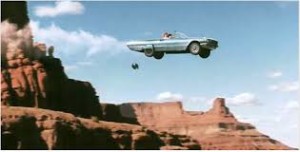Nothing New After Act Two

One of story checkmarks you learn writing for the movies is
Every main character should be introduced in Act One.
Though Harrison Ford wasn’t onscreen early in “Blade Runner 2049,” he was in our minds from the original “Blade Runner”
This precept is probably not as critical for novels, where we have more time for the story to unfold and for new faces to appear. But it still seems to me a good rule.
Get everybody onstage early.
(Including key props and concepts like the ’66 Ford Thunderbird convertible that Thelma and Louise will have their adventures in and the Tyrell Corporation’s invention of the latest series of replicants.)
The last thing we want is for some important character to wander onto the scene on page 286. It feels like a cheat. The reader, remember, is solving the story puzzle along with us as she reads. She’s asking herself, “Will Elizabeth Bennet wind up with Mr. Darcy?” If we, the writers, hold back some important character—say, a possible rival for Liz’s hand—the reader will feel we’re not playing fair with her.
Likewise, and for the same reason, we risk alienating the reader if we bring in ANYTHING new in Act Three.
Act Three, as we said last week, is the ninth inning. In the third act, we put the pedal to the metal and highball into the climax.
In the story I’ve been working on (the “Reports from the Trenches” story), I kept a file I called Stuff We Need to Get In. In it were four or five of what I thought were really cool concepts or insights that the reader would like and that would really enhance the story.
Then I got to Act Three.

Get that T-bird onstage early.
Each time I thought to myself, “Ah, here’s a spot we can get in Thought #1,” I realized it was too late. The story was rolling too fast toward the climax. If I paused, even for a single extra paragraph, the momentum would stall. So …
Cut.
Cut.
Cut.
One by one, my cool little notions bit the dust.
The good news: when I looked back, I realized I didn’t miss them.
Momentum is everything in Act Three.
Once Luke and his buddies are closing in on the Death Star, there’s no time for backstory about Chewbacca.
Once Ahab learns that Moby Dick is just beyond the horizon, it’s, “Set all sails, ye lubbers!”
Nothing new after Act Two.





This was exactly what I needed to see this morning. Thank you!
Whew! It’s a relief and a challenge at the same time, getting everybody and everything in there early. Wow, what a revelation today… Like packing for the trip.
That’s a great analogy! What ain’t in the case won’t be with us on the cruise.
Having a character introduced in Act 3 is enough to make me throw the book against the wall – thanks for this important reminder!
I agree, and this fits with your other lesson that the opening scene should foreshadow the climax.
PS: Steve, I emailed you and Shawn my proposal to co-create a
“War of Art Academy” online to help Amateurs implement your teachings and support them to Turn Pro.
Please give it a read and Reply or call me with a “F*CK YES! or a Hell NO.”
Thanks,
Brendon
As usual, excellent lesson.
Taking notes…
These little nuggets are wonderful, and a masterclass in and of itself.
Simple wisdom…uncommon sense..that so needs to be said. I appreciate so much your posts closing the gap between knowing and doing.
Thanks, Steve.
Thanks for this reminder. I was pleased to see that, when I looked over the draft of a nonfiction book I’ve been working on, I followed that rule. Your insights into story structure, both here and in Nobody Wants to Read Your Sh*t, are amazingly helpful.
David
The Act 3 rule is one reason why Bladerunner 2049 did not work for me. That army appeared out of nowhere. There were other reasons, too.